
Dionisis Christofilogiannis (b. 1973, Greece) lives and works in Athens. Currently, he is a Visual Arts instructor at the American College of Greece DEREE. Dionisis’ artistic approach deals with a dialogue between different types of art. His works dominate the architectural element and geometrical forms where simplicity, purity, and abstraction come together with beautification and lyricism. He comments on the contemporary social, economic and political disorder where the right to housing, a fundamental human right, is placed under constant questioning.
Recent exhibitions include: CITYX Venice Italian Virtual Pavilion of the 17th Venice Architecture Biennale, EMST – National Museum of Contemporary Art Greece, MOMus Thessaloniki, and Biennale 6: Thessaloniki, State Museum of Contemporary Art of Thessaloniki, Contemporary Museum of Naples, Museo of Contemporary arts Iberoamericano (Museo Extremeño e Iberoamericano de Arte Contemporáneo (MEIAC) or Ibero-American Museum of Contemporary Art), Muzeul de Artă ClujNapoca, Nakagawa Gallery Tokyo, Hydra School Projects, Luciano Benetton Collection, KunsthalleAthens, Celeste Prize-New York, Benaki Museum Athens, TINA-B Prague. Has also co-curated several exhibitions, including “In the Studio” at Kunsthalle Athens (2013); “I fought the X and the X won”, at the National Museum of Malta and Romania (2011); “The Cutting Edge” in Romania (2011). He is also a set designer and has collaborated with important directors, such as Razvan Mazilu at the National Theater of Timisoara, and Robert Wilson at the National Theater in Athens.
Recent exhibitions include: CITYX Venice Italian Virtual Pavilion of the 17th Venice Architecture Biennale, EMST – National Museum of Contemporary Art Greece, MOMus Thessaloniki, and Biennale 6: Thessaloniki, State Museum of Contemporary Art of Thessaloniki, Contemporary Museum of Naples, Museo of Contemporary arts Iberoamericano (Museo Extremeño e Iberoamericano de Arte Contemporáneo (MEIAC) or Ibero-American Museum of Contemporary Art), Muzeul de Artă ClujNapoca, Nakagawa Gallery Tokyo, Hydra School Projects, Luciano Benetton Collection, KunsthalleAthens, Celeste Prize-New York, Benaki Museum Athens, TINA-B Prague. Has also co-curated several exhibitions, including “In the Studio” at Kunsthalle Athens (2013); “I fought the X and the X won”, at the National Museum of Malta and Romania (2011); “The Cutting Edge” in Romania (2011). He is also a set designer and has collaborated with important directors, such as Razvan Mazilu at the National Theater of Timisoara, and Robert Wilson at the National Theater in Athens.




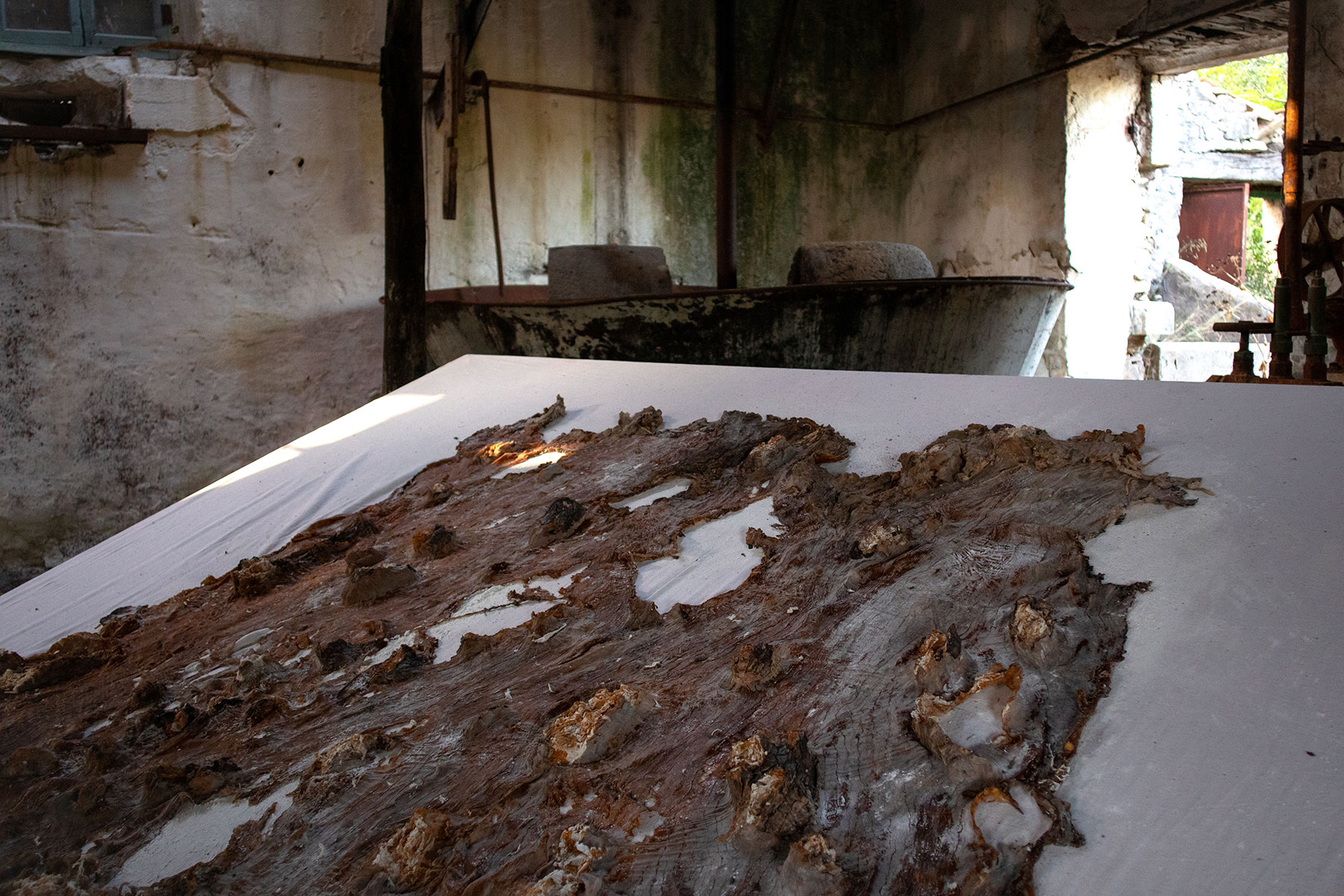
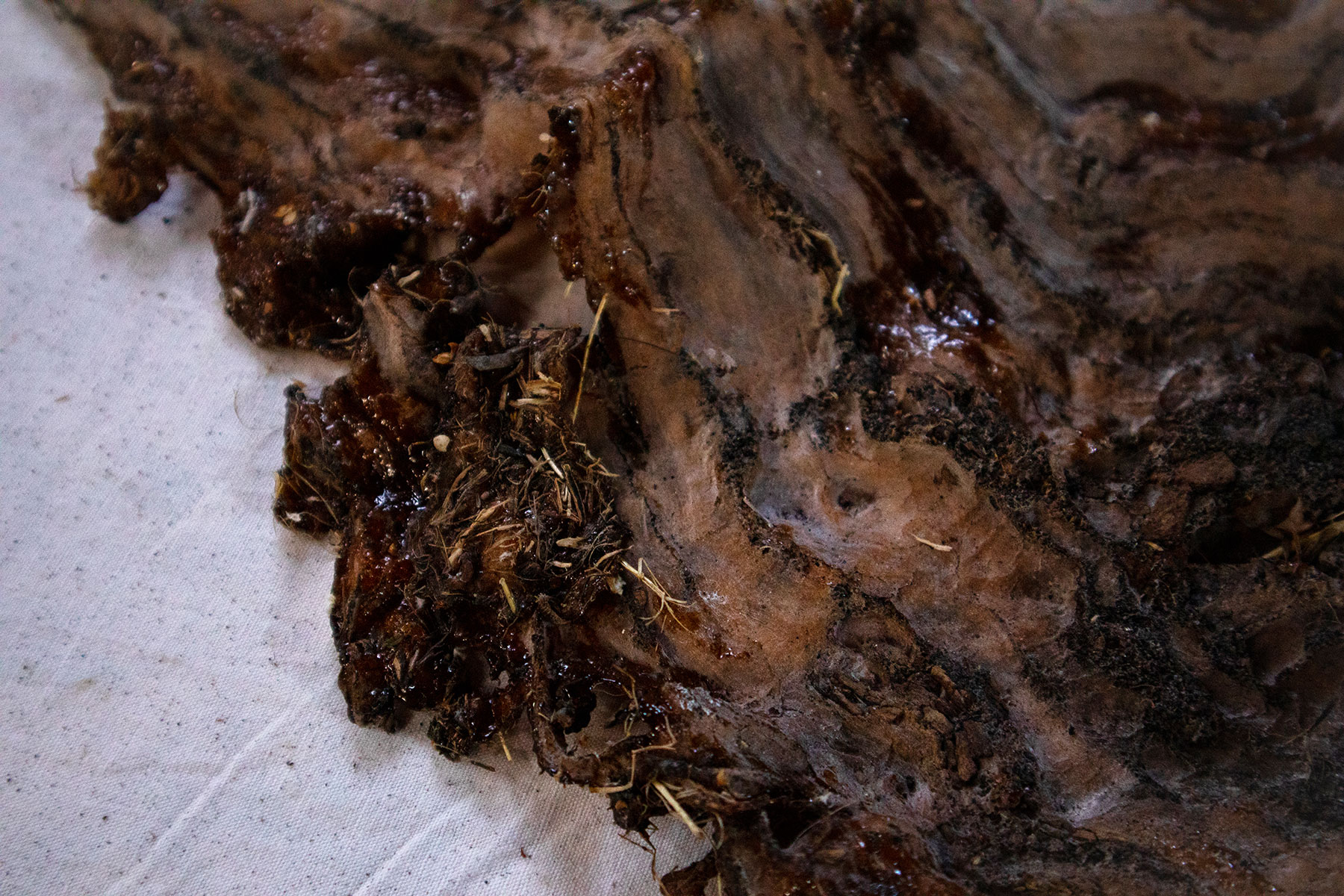



SKIN by
Dionisis Christofillogiannis
installation, 250x250cm
latex on linen
2024
location: 39.224076, 20.148282
The concept for a contemporary artwork The Skin involving latex and an olive tree merges the realms of natural history and tactile art, offering a profound commentary on the relationship between nature and human interaction.
Through The Skin the artist not only captures the physical essence of the olive tree but also evokes a deeper reflection on the themes of preservation, transformation, and the impermanence of life. This contemporary artwork bridges the gap between the tangible and the ephemeral, offering a unique perspective on the beauty and complexity of the natural world.
The Skin is a contemporary art installation that explores the intricate relationship between humanity and the natural world. The artwork consists of a latex thin layer meticulously molded resemble human skin, delicately draped over the surface of an olive tree.
This installation serves as a metaphorical exploration of the interconnectedness between humans and trees, highlighting the parallels between the skin that cloaks our bodies and the bark that protects and sustains trees. The olive tree, with its ancient symbolism of peace, wisdom, and endurance, becomes a canvas for this thought-provoking juxtaposition. The latex layer, with its lifelike texture and appearance, blurs the boundaries between the organic and the synthetic, inviting viewers to contemplate the fragility and resilience of both human and arboreal existence. As visitors approach the installation, they are confronted with the uncanny resemblance of the tree's surface to human flesh, prompting introspection on our shared vulnerability and mortality.
https://dionisischristofilogiannis.wordpress.com/
installation, 250x250cm
latex on linen
2024
location: 39.224076, 20.148282
The concept for a contemporary artwork The Skin involving latex and an olive tree merges the realms of natural history and tactile art, offering a profound commentary on the relationship between nature and human interaction.
Through The Skin the artist not only captures the physical essence of the olive tree but also evokes a deeper reflection on the themes of preservation, transformation, and the impermanence of life. This contemporary artwork bridges the gap between the tangible and the ephemeral, offering a unique perspective on the beauty and complexity of the natural world.
The Skin is a contemporary art installation that explores the intricate relationship between humanity and the natural world. The artwork consists of a latex thin layer meticulously molded resemble human skin, delicately draped over the surface of an olive tree.
This installation serves as a metaphorical exploration of the interconnectedness between humans and trees, highlighting the parallels between the skin that cloaks our bodies and the bark that protects and sustains trees. The olive tree, with its ancient symbolism of peace, wisdom, and endurance, becomes a canvas for this thought-provoking juxtaposition. The latex layer, with its lifelike texture and appearance, blurs the boundaries between the organic and the synthetic, inviting viewers to contemplate the fragility and resilience of both human and arboreal existence. As visitors approach the installation, they are confronted with the uncanny resemblance of the tree's surface to human flesh, prompting introspection on our shared vulnerability and mortality.
https://dionisischristofilogiannis.wordpress.com/



Carolina Amaya (b. 1981 Colombia), is a contemporary artist based in Berlin. She decided to relocate to Berlin in 2016 where she has since established a thriving art practice. Working from her studio, Amaya takes part in both national and international projects and exhibitions.
Carolina Amaya's work explores the idea of transformation in the mental programming of the belief system that governs society. She manages to break free from these rigid structures, by being in a moment of pure presence, creating new interpretations of her work and allowing for complete freedom of expression where intense, gentle, rapid, or energetic moments are created through the interaction between the materials. She calls this process "Ancestral Skins" which involves creating organized, ordered, schematic, sequential, and repetitive organic patterns and layering them with thick, gestural, and abstract marks of charcoal that seem to destroy the original image but instead, she´s reorganizing and transforming them into new impulses and ways of expression.
She has an extensive exhibition activity in Berlin, showcasing her work in notable galleries such as Zwitschermaschine Galerie (2018), Lite Haus Gallery (2019), FoYou (2019-2022), Z22 (2021), Game Over NFT Museum Berlin (2022), VBK Gallery (2021-2022) and AtelierHof (2023) She has also participated in several group exhibitions at prestigious venues, including KaDeWe Berlin, Oberpollinger Munich, and Alsterhaus Hamburg (2021). In addition, Amaya has also created several urban interventions in cities such as Berlin, Munich, Hamburg, and her hometown of Bogotá. In 2016, she was the first Colombian artist to become a member of VBK (Verein Berliner Künstler).
Carolina Amaya's work explores the idea of transformation in the mental programming of the belief system that governs society. She manages to break free from these rigid structures, by being in a moment of pure presence, creating new interpretations of her work and allowing for complete freedom of expression where intense, gentle, rapid, or energetic moments are created through the interaction between the materials. She calls this process "Ancestral Skins" which involves creating organized, ordered, schematic, sequential, and repetitive organic patterns and layering them with thick, gestural, and abstract marks of charcoal that seem to destroy the original image but instead, she´s reorganizing and transforming them into new impulses and ways of expression.
She has an extensive exhibition activity in Berlin, showcasing her work in notable galleries such as Zwitschermaschine Galerie (2018), Lite Haus Gallery (2019), FoYou (2019-2022), Z22 (2021), Game Over NFT Museum Berlin (2022), VBK Gallery (2021-2022) and AtelierHof (2023) She has also participated in several group exhibitions at prestigious venues, including KaDeWe Berlin, Oberpollinger Munich, and Alsterhaus Hamburg (2021). In addition, Amaya has also created several urban interventions in cities such as Berlin, Munich, Hamburg, and her hometown of Bogotá. In 2016, she was the first Colombian artist to become a member of VBK (Verein Berliner Künstler).


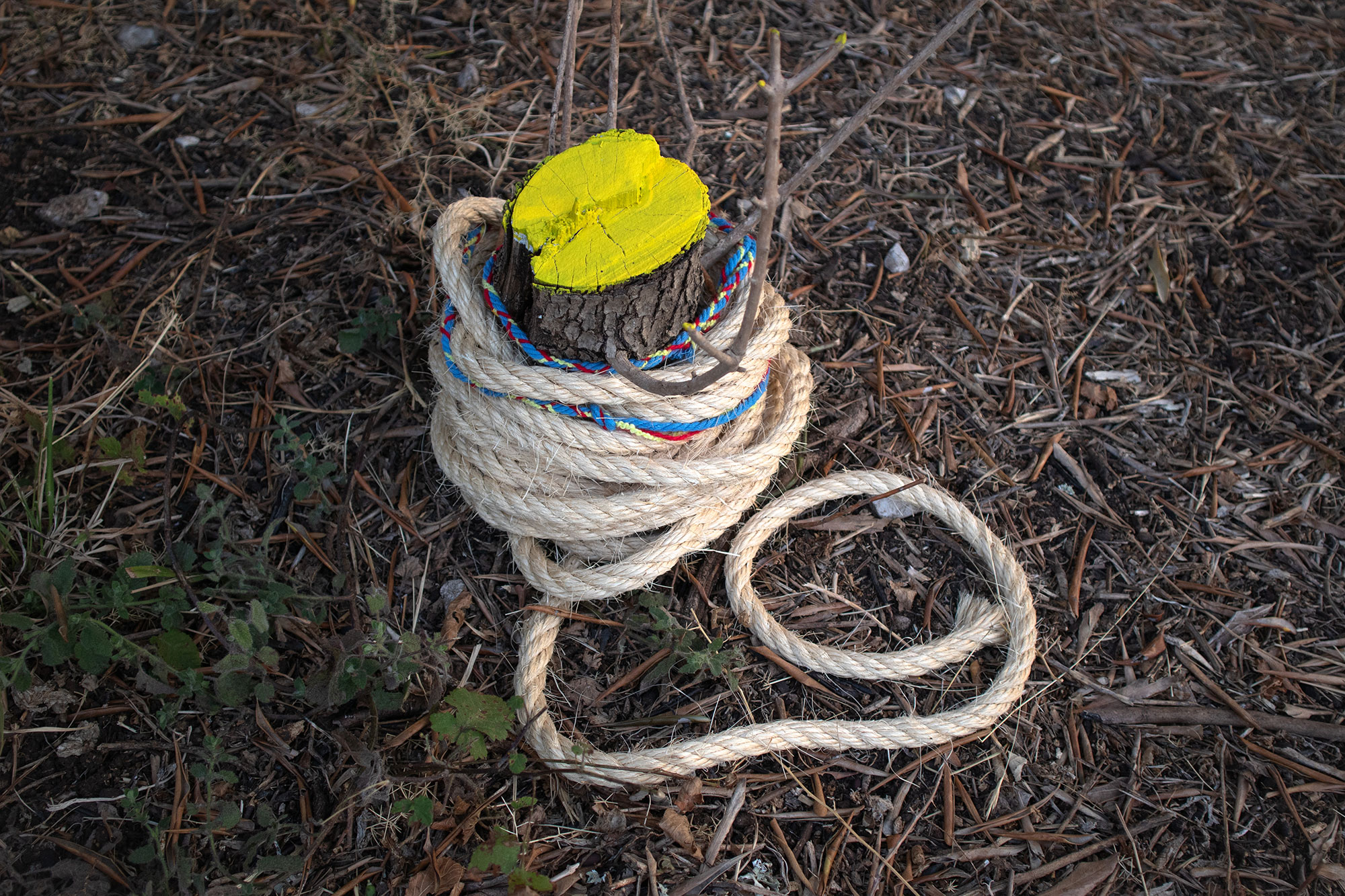





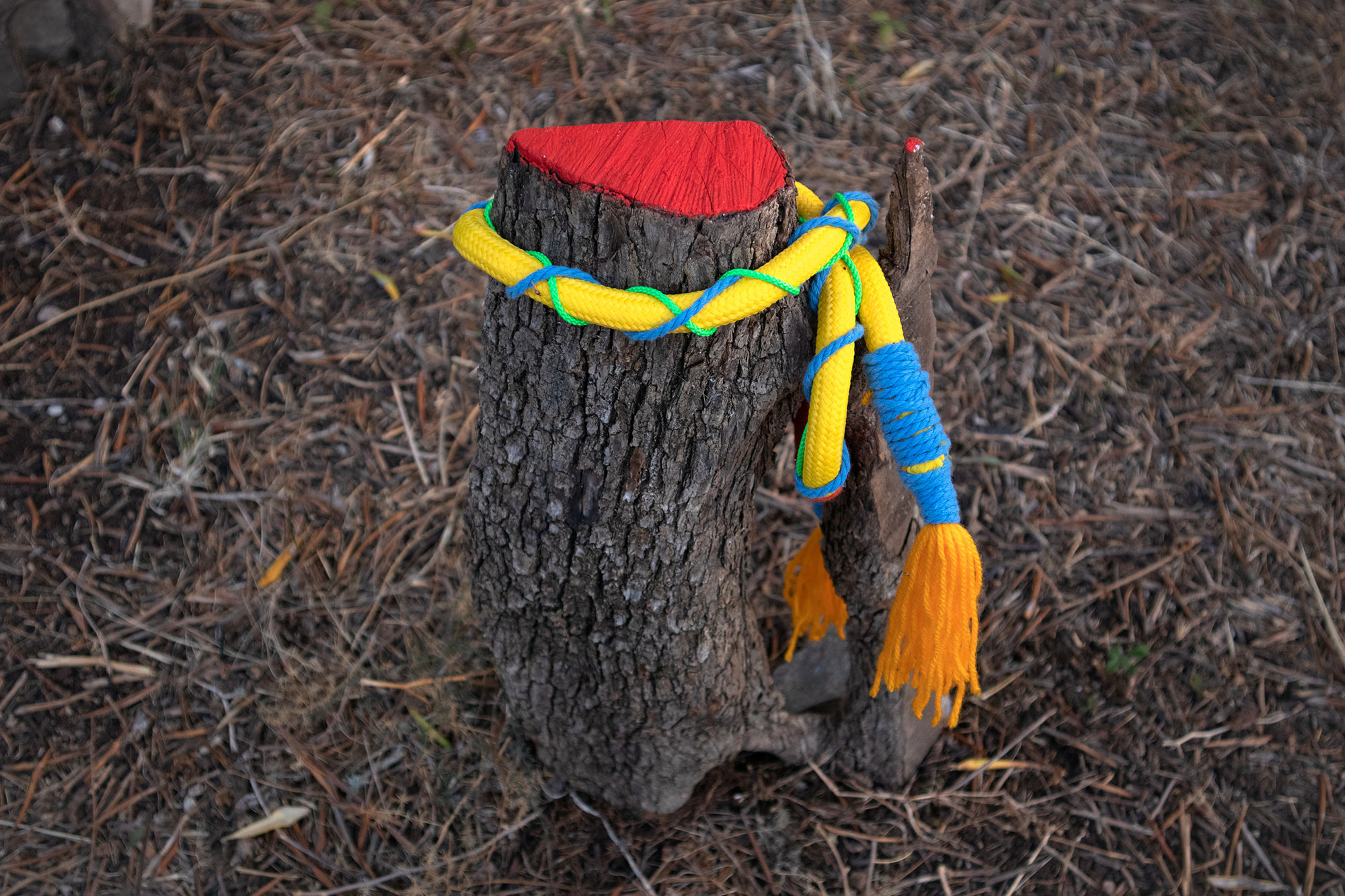


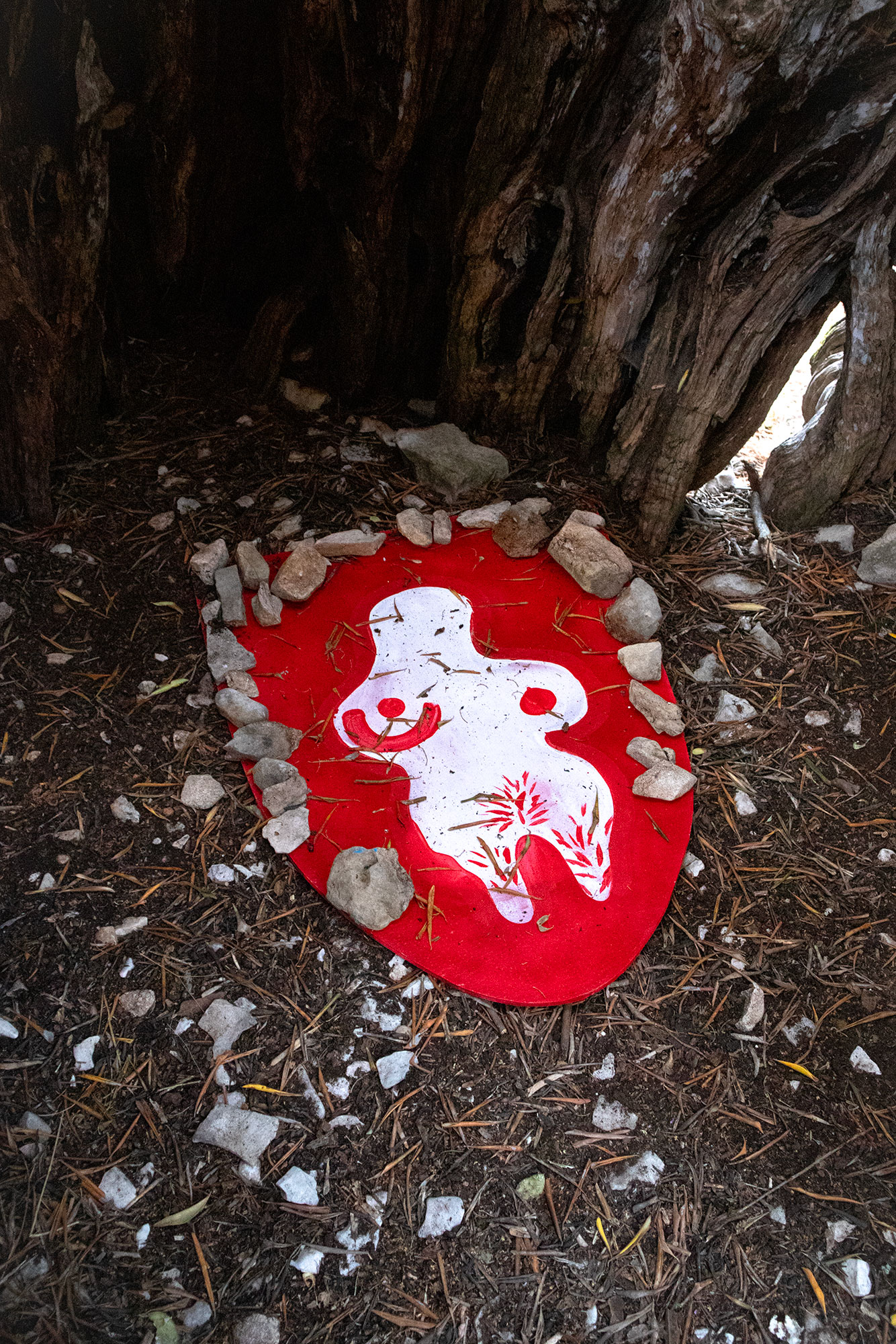


BONDS OF KINDNESS by Carolina Amaya
installation, 40m2
fabrics, wool, clay, boat ropes, chunky yarn, wood, acrylic, tree branches, metal
2024
location: 39.209608, 20.157305
Abundance is our natural law, indigenous peoples lived this knowledge. Abundance demands respect and carries a feminine energy. In most areas of the world, braiding is an activity that women do. It includes the care of the hair and the patience and calm necessary to create complex works of art on their heads. In today's time of upheaval, it is obvious that we need more and more feminine energy to heal a masculine and patriarchal past.
In Colombia, as part of our farming culture, there is a tradition of giving away braids that contain garlic, coffee, lentils, and colors. The desire to give kindness and abundance to your loved ones is deeply rooted and practically woven into our culture. These braids cannot be purchased, they can only be given as a present. People believe that these braids restore contact with a universal flow of nature that brings prosperity. “Bonds of Kindness” art installation is a response to this imbalance, an art installation that symbolizes femininity, fertility, and flow. Hundreds of small single braids make one huge mother braid made from cords of dyed cotton mixed with rope from local fishermen. A gift from Colombia to Greece, Bond of Kindness carries the essence of Athena and the ancient matrilineal systems, the principle of lived balance, intuition, and the natural cycle of life. This gift serves as a reminder of the importance of living both masculine and feminine energies.
Like the olive tree, the bacterium is also part of nature, part of a complex system, and does its work without any ill will. You can't blame Xylella for this. Perhaps the reason for his success lies on a purely factual level. But if a spiritual symbol is in mortal danger, why not look for a solution in non-fact-based areas?
To take a stand against powerlessness, these braids are located around the olive tree as a way to embrace the energy of this ancestral grandmother 2500 years old. These braids that I call “Bonds of Kindness”, give them strength through these gifts, and reconnect them with the universal flow of prosperity. But perhaps the bonds should also remind us humans to be friendly again. children to the trees, which are far too often just exploited slaves of profit maximization—children to the plants, children to ourselves. Various elements, abstract and symbolic, are woven into the colored braids. Small abstract sculptures carry the seeds of the olive tree, just like in the original Bonds of Kindness in Colombia, where we use mostly coffee beans and garlic.
www.carolinaamaya.com/berlin-studio
installation, 40m2
fabrics, wool, clay, boat ropes, chunky yarn, wood, acrylic, tree branches, metal
2024
location: 39.209608, 20.157305
Abundance is our natural law, indigenous peoples lived this knowledge. Abundance demands respect and carries a feminine energy. In most areas of the world, braiding is an activity that women do. It includes the care of the hair and the patience and calm necessary to create complex works of art on their heads. In today's time of upheaval, it is obvious that we need more and more feminine energy to heal a masculine and patriarchal past.
In Colombia, as part of our farming culture, there is a tradition of giving away braids that contain garlic, coffee, lentils, and colors. The desire to give kindness and abundance to your loved ones is deeply rooted and practically woven into our culture. These braids cannot be purchased, they can only be given as a present. People believe that these braids restore contact with a universal flow of nature that brings prosperity. “Bonds of Kindness” art installation is a response to this imbalance, an art installation that symbolizes femininity, fertility, and flow. Hundreds of small single braids make one huge mother braid made from cords of dyed cotton mixed with rope from local fishermen. A gift from Colombia to Greece, Bond of Kindness carries the essence of Athena and the ancient matrilineal systems, the principle of lived balance, intuition, and the natural cycle of life. This gift serves as a reminder of the importance of living both masculine and feminine energies.
Like the olive tree, the bacterium is also part of nature, part of a complex system, and does its work without any ill will. You can't blame Xylella for this. Perhaps the reason for his success lies on a purely factual level. But if a spiritual symbol is in mortal danger, why not look for a solution in non-fact-based areas?
To take a stand against powerlessness, these braids are located around the olive tree as a way to embrace the energy of this ancestral grandmother 2500 years old. These braids that I call “Bonds of Kindness”, give them strength through these gifts, and reconnect them with the universal flow of prosperity. But perhaps the bonds should also remind us humans to be friendly again. children to the trees, which are far too often just exploited slaves of profit maximization—children to the plants, children to ourselves. Various elements, abstract and symbolic, are woven into the colored braids. Small abstract sculptures carry the seeds of the olive tree, just like in the original Bonds of Kindness in Colombia, where we use mostly coffee beans and garlic.
www.carolinaamaya.com/berlin-studio



Vasilis Galanis (b.1994, Greece) lives and works in Athens.
He studied at the School of Visual and Applied Arts of the Faculty of Fine Arts, Aristotle University of Thessaloniki (2012-2017) from which he graduated with high honors (9.56/10) and holds an MFA from the Athens School of Fine Arts (2019-2021), also with high honors. In 2016-2017, he attended classes at the Instituto Politecnico de Lisboa, in Portugal. He has been awarded the Stavros Niarchos Foundation Artist Fellowship by ARTWORKS in 2022. His work has been shown in numerous group and two solo/duo shows in Greece and in 2021, he participated in the 14th International Painting Symposium in Luxor, Egypt. Besides visual arts, he has published articles related to his research interests (newspaper Ta Nea, kato exhibition publication etc.) and has performed in a theatrical play in Ancient Theater of Aigeira, supported by the Greek National Opera. His research interests revolve around themes such as science-fiction, power relations, technology, art history and mass culture.
He is currently a PhD candidate a University of Crete.
He studied at the School of Visual and Applied Arts of the Faculty of Fine Arts, Aristotle University of Thessaloniki (2012-2017) from which he graduated with high honors (9.56/10) and holds an MFA from the Athens School of Fine Arts (2019-2021), also with high honors. In 2016-2017, he attended classes at the Instituto Politecnico de Lisboa, in Portugal. He has been awarded the Stavros Niarchos Foundation Artist Fellowship by ARTWORKS in 2022. His work has been shown in numerous group and two solo/duo shows in Greece and in 2021, he participated in the 14th International Painting Symposium in Luxor, Egypt. Besides visual arts, he has published articles related to his research interests (newspaper Ta Nea, kato exhibition publication etc.) and has performed in a theatrical play in Ancient Theater of Aigeira, supported by the Greek National Opera. His research interests revolve around themes such as science-fiction, power relations, technology, art history and mass culture.
He is currently a PhD candidate a University of Crete.

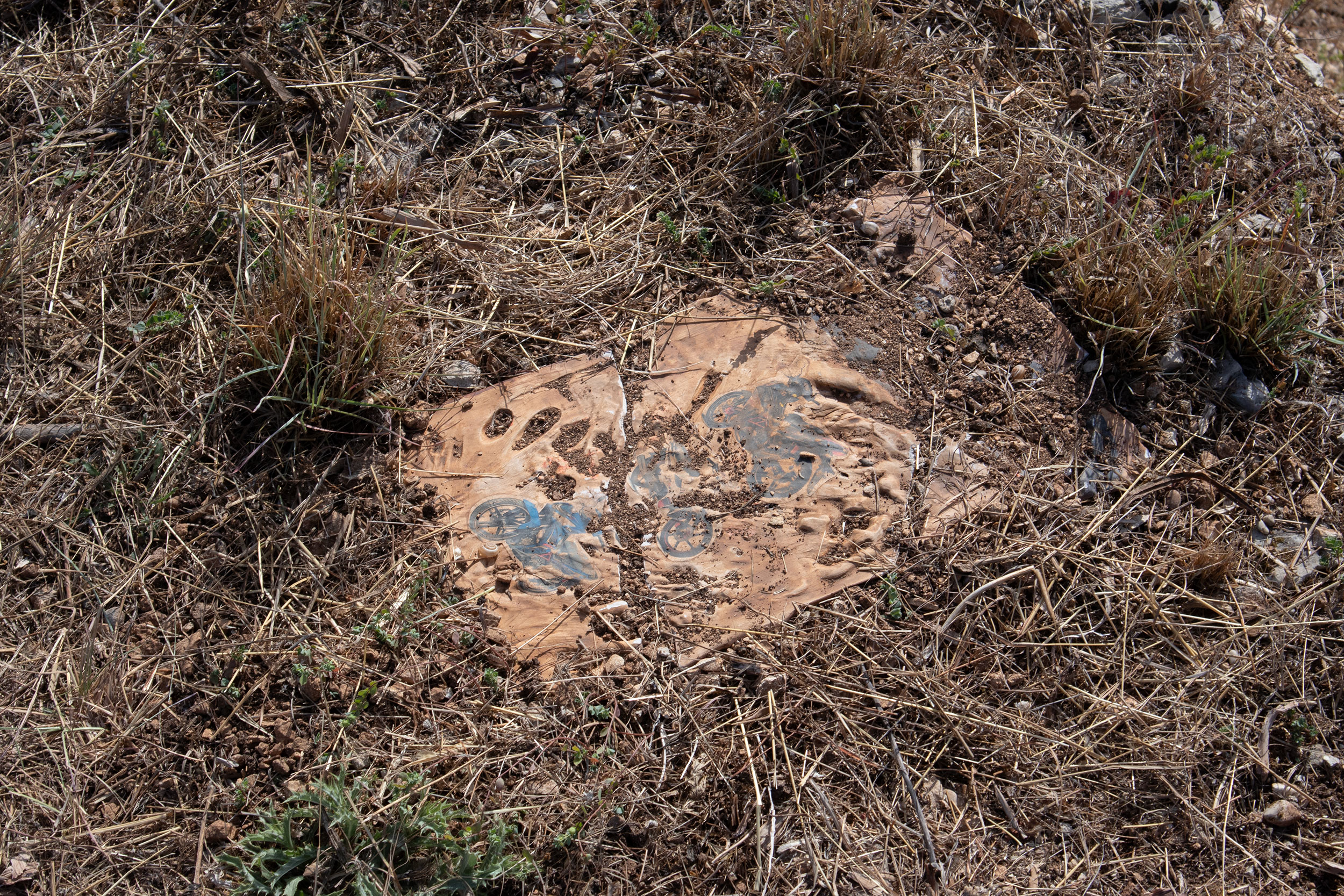


FOSSIL (Machine Genealogies) by Vasilis Galanis
public intervention, 20x30cm
ink, paper, plaster, sand
2020
location: 39.193784, 20.193512
Fossils is a series of artworks, combining imagery of technology that runs on fossil fuels with fossilized creatures from the depths of prε-history. More specifically, it is based on a wordplay on the Greek words “παπί-πάπια” which share the meaning of duck and small motorcycle together. Images of distant-relatives of ducks are juxtaposed with found images of motorcycles which run on fossil fuels made millennia ago, aiming to make a comment on the interconnectedness of existence on Earth and the inherent humor language may sometimes bear.
www.instagram.com/vasil_galanis
public intervention, 20x30cm
ink, paper, plaster, sand
2020
location: 39.193784, 20.193512
Fossils is a series of artworks, combining imagery of technology that runs on fossil fuels with fossilized creatures from the depths of prε-history. More specifically, it is based on a wordplay on the Greek words “παπί-πάπια” which share the meaning of duck and small motorcycle together. Images of distant-relatives of ducks are juxtaposed with found images of motorcycles which run on fossil fuels made millennia ago, aiming to make a comment on the interconnectedness of existence on Earth and the inherent humor language may sometimes bear.
www.instagram.com/vasil_galanis



Dimitris Kontodimos
(b. 1994 Greece) is a visual artist based in Athens.
In recent years, using painting and installations as his main medium, he has been creating works based on the urban landscape and city life. Born and raised in Athens, the idea of the city has always existed both as an experience and as a daily stimulus.
He studied at the Department of Plastic Arts and Art Sciences, School of Fine Arts, University of Ioannina, Greece. During his undergraduate studies, he received an annual scholarship to study Erasmus at the facultad de bellas artes at the Universidad Complutense de Madrid in 2017-2018. In 2021 he graduated from the Master of Fine Arts at the Athens School of Fine Arts. Since 2014 he has been presenting his work in exhibitions in Greece & abroad, most notably shows were at BACK TO ATHENS 9 & 10, «Eleonas ‘23 - Chthonios and Anthropocene», Mystery 56 - In from the Margins at Eleusis 2023 and Art Athina 2024 with Space52.
In recent years, using painting and installations as his main medium, he has been creating works based on the urban landscape and city life. Born and raised in Athens, the idea of the city has always existed both as an experience and as a daily stimulus.
He studied at the Department of Plastic Arts and Art Sciences, School of Fine Arts, University of Ioannina, Greece. During his undergraduate studies, he received an annual scholarship to study Erasmus at the facultad de bellas artes at the Universidad Complutense de Madrid in 2017-2018. In 2021 he graduated from the Master of Fine Arts at the Athens School of Fine Arts. Since 2014 he has been presenting his work in exhibitions in Greece & abroad, most notably shows were at BACK TO ATHENS 9 & 10, «Eleonas ‘23 - Chthonios and Anthropocene», Mystery 56 - In from the Margins at Eleusis 2023 and Art Athina 2024 with Space52.

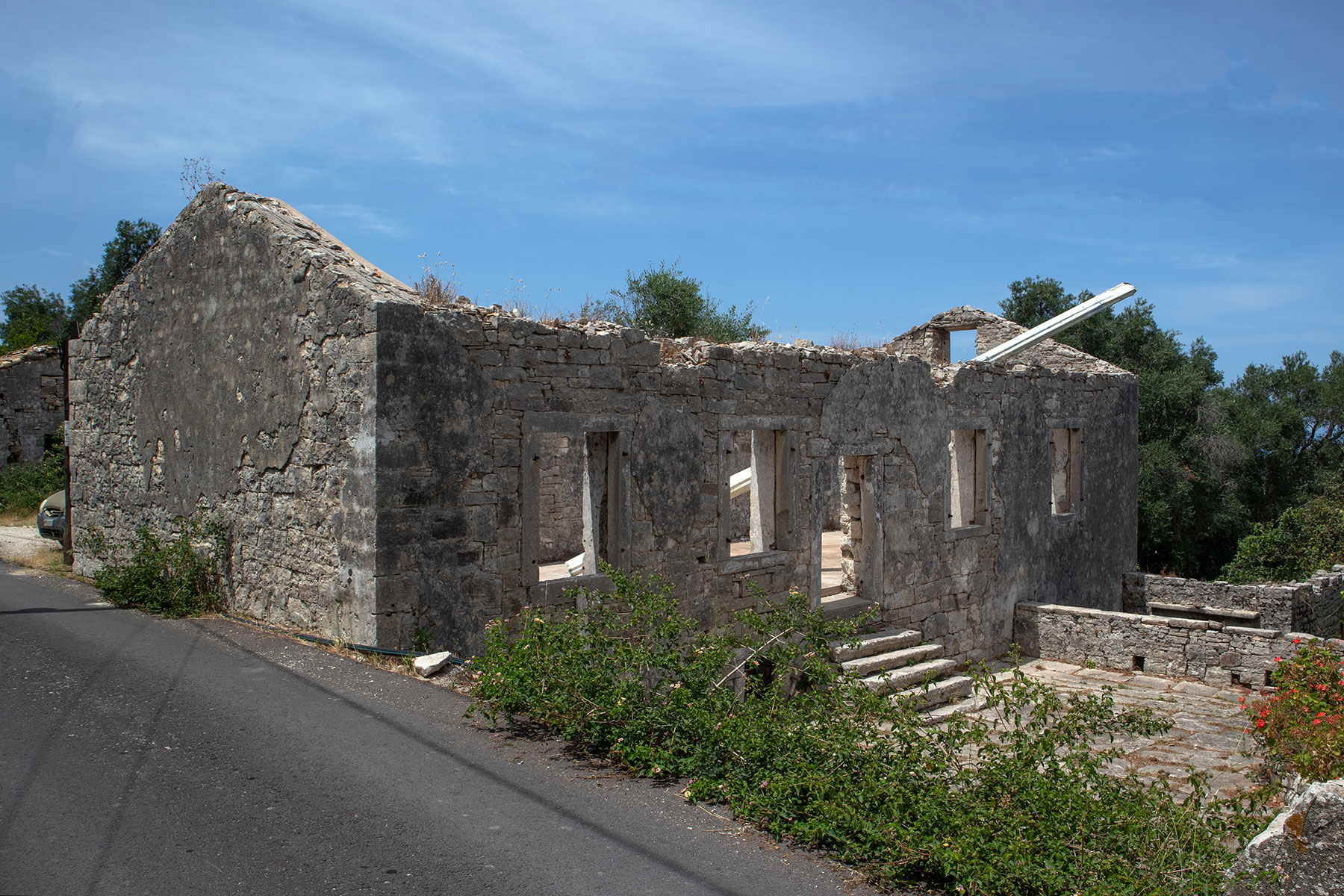



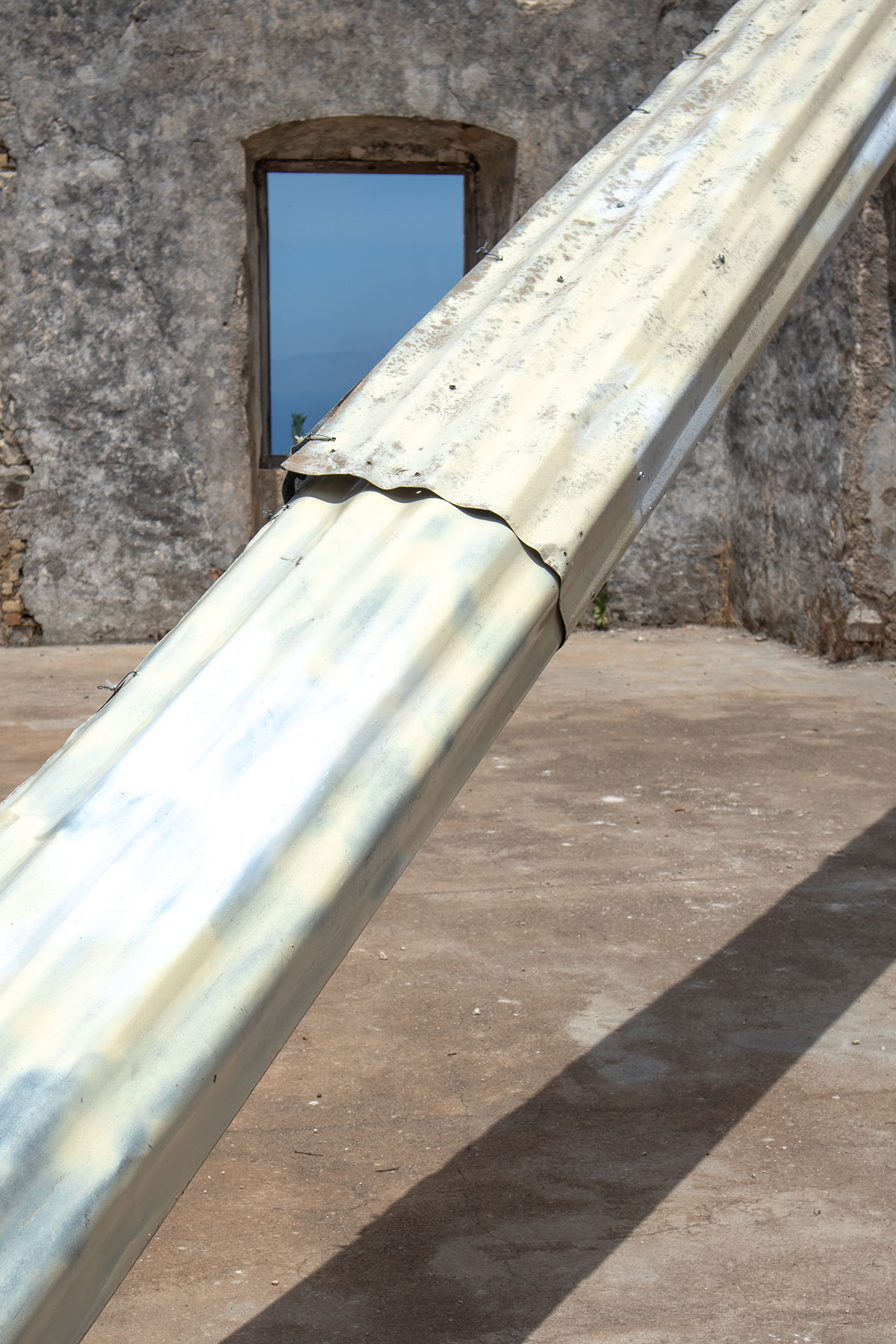

9,17 METERS OF REUSED MEMORY by
Dimitris Kontodimos
installation
metal sheets, spray paint
2024
location: 39.217481, 20.158407
The project 9.17m of reused memory consists of a series of construction sheets forming a column that intersects and reacts with the architectural space of the building. An everyday and usually indifferent material such as construction sheet takes on the project a form that reminds of the monumental and the highest. At the same time, in a place where continuous construction seems to change the image of the island, the sheet metal has yet another symbolic meaning. Starting from the concept of the exhibition around memory, the work I am presenting comments on two aspects of collective memory. On the one hand, the symbolism of the column, which is qn internationall trademark of historicity, and on the other, the very memory of the materials and their reusability. For this project I use materials found in the island that carry signs of previous use, and I reuse them myself, giving in turn another layer to the history and memory of the material.
www.instagram.com/dim_kontodimos
installation
metal sheets, spray paint
2024
location: 39.217481, 20.158407
The project 9.17m of reused memory consists of a series of construction sheets forming a column that intersects and reacts with the architectural space of the building. An everyday and usually indifferent material such as construction sheet takes on the project a form that reminds of the monumental and the highest. At the same time, in a place where continuous construction seems to change the image of the island, the sheet metal has yet another symbolic meaning. Starting from the concept of the exhibition around memory, the work I am presenting comments on two aspects of collective memory. On the one hand, the symbolism of the column, which is qn internationall trademark of historicity, and on the other, the very memory of the materials and their reusability. For this project I use materials found in the island that carry signs of previous use, and I reuse them myself, giving in turn another layer to the history and memory of the material.
www.instagram.com/dim_kontodimos


 photo © Nicolas Melemis
photo © Nicolas MelemisZoe Metra (b. 1997, France) is a visual artist lives and works between Paris and Athens. In 2021 she graduated from Econale Nationale Supérieure des Beaux Arts de Lyon.
Since then her work focuses on the creation of portraits in a variety of media. In her work, she challenges reality by portraying real characters who flirt with fiction through reinvented personal mythologies. In her practice, she refers to childhood and adolescence as mental spaces to b re-explored and traversed. Through films, photographs and installations, she assembles emblematic elements of 2010s visual culture to create narrative universes that deviate from their initial readings, using recognizable objects or spaces such as puzzles or playgrounds, which she displaces into paralle worlds through her voice, the narrative she affixes to them, or the images she associates with them. These works are retreats, rooms, for marginal and strange characters, too sensitive to expose themselves to reality. In them, she says, she gives a voice to the unseen, to those who hide within ourselves. By fictionalizing objects and distorting familiar spaces, she creates a disturbance, a thrill, confronting viewers with their own troubles.
Her work has been exhibited at Sissi Club (Marseille), Monopole (Lyon), Villa Belleville (Paris), Hua International (Berlin), at Le point commun (CranGevrier,Annecy) Grand Palais Ephémère (Paris), Garage Mü (Paris), Okay Space (Athens), Tour Orion(Montreuil), at 3537 (Paris), Iesa (Paris), in conjunction with the Lyon Biennial 2022, Dragono (Paris), Æther (Sofia), Doc (Paris), Tarsia (Naples). She was in residence at Villa Beleville in 2023. She worked alongside Maria Papadimitriou on the Souzy Tros project in in Athens. She also worked with the Pane Per Poveri collective on various projects between Berlin and between Berlin and Venice His curatorial experience began with Captain Stavros in 2023 for the Dandelion Seekers project.
Since then her work focuses on the creation of portraits in a variety of media. In her work, she challenges reality by portraying real characters who flirt with fiction through reinvented personal mythologies. In her practice, she refers to childhood and adolescence as mental spaces to b re-explored and traversed. Through films, photographs and installations, she assembles emblematic elements of 2010s visual culture to create narrative universes that deviate from their initial readings, using recognizable objects or spaces such as puzzles or playgrounds, which she displaces into paralle worlds through her voice, the narrative she affixes to them, or the images she associates with them. These works are retreats, rooms, for marginal and strange characters, too sensitive to expose themselves to reality. In them, she says, she gives a voice to the unseen, to those who hide within ourselves. By fictionalizing objects and distorting familiar spaces, she creates a disturbance, a thrill, confronting viewers with their own troubles.
Her work has been exhibited at Sissi Club (Marseille), Monopole (Lyon), Villa Belleville (Paris), Hua International (Berlin), at Le point commun (CranGevrier,Annecy) Grand Palais Ephémère (Paris), Garage Mü (Paris), Okay Space (Athens), Tour Orion(Montreuil), at 3537 (Paris), Iesa (Paris), in conjunction with the Lyon Biennial 2022, Dragono (Paris), Æther (Sofia), Doc (Paris), Tarsia (Naples). She was in residence at Villa Beleville in 2023. She worked alongside Maria Papadimitriou on the Souzy Tros project in in Athens. She also worked with the Pane Per Poveri collective on various projects between Berlin and between Berlin and Venice His curatorial experience began with Captain Stavros in 2023 for the Dandelion Seekers project.

IN LOVING MEMORY by Zoe Metra
installation, 54x76cm
wood, paint
2024
location: 39.231586, 20.151531
Curator’s text:
What is memory, and what happens to humans when they lose it? Zoe Metra’s white puzzle piece, installed in a natural environment on an old rocky wall that holds and protects the soil, roots, and trees, serves as a metaphor for the unknown. The environment becomes a puzzle game with one piece missing. How can we preserve ourselves in an evolving world without losing our values, culture, and nature? As more pieces go missing, tomorrow might bring even more, until everything turns white, empty, and emotionless.
installation, 54x76cm
wood, paint
2024
location: 39.231586, 20.151531
Curator’s text:
What is memory, and what happens to humans when they lose it? Zoe Metra’s white puzzle piece, installed in a natural environment on an old rocky wall that holds and protects the soil, roots, and trees, serves as a metaphor for the unknown. The environment becomes a puzzle game with one piece missing. How can we preserve ourselves in an evolving world without losing our values, culture, and nature? As more pieces go missing, tomorrow might bring even more, until everything turns white, empty, and emotionless.
www.instagram.com/zoe_metra/



Dimitra Zervou
(b. 1992 Greece) lives and works in Athens. She holds an Integrated MA from the Athens School of Fine Arts. She is using sculptures and installations as mediums and creating narratives that examine memory and its essence throughout time.
She has participated in exhibitions and projects in Greece and abroad, such as: Layers of perception: Exploring depths - Untiled Gallery Sofia (2024), Mystery 56 - 4th Culture 2030 meeting - Eleusis European Capital of Culture 2023, Contemporary Womanhood 1.0: present femininities - MOMus-Museum Alex Mylona Athens (2023), Sewage or What Will Be Remembered By, with the grant of the Ministry of Culture, All of Greece one Culture 2023 Cephalonia (2023), Community tools - Back to Athens 9, Isaiah Mansion Athens (2022), Michael Cacoyannis Foundation Athens (2017) and more.
She has participated in exhibitions and projects in Greece and abroad, such as: Layers of perception: Exploring depths - Untiled Gallery Sofia (2024), Mystery 56 - 4th Culture 2030 meeting - Eleusis European Capital of Culture 2023, Contemporary Womanhood 1.0: present femininities - MOMus-Museum Alex Mylona Athens (2023), Sewage or What Will Be Remembered By, with the grant of the Ministry of Culture, All of Greece one Culture 2023 Cephalonia (2023), Community tools - Back to Athens 9, Isaiah Mansion Athens (2022), Michael Cacoyannis Foundation Athens (2017) and more.
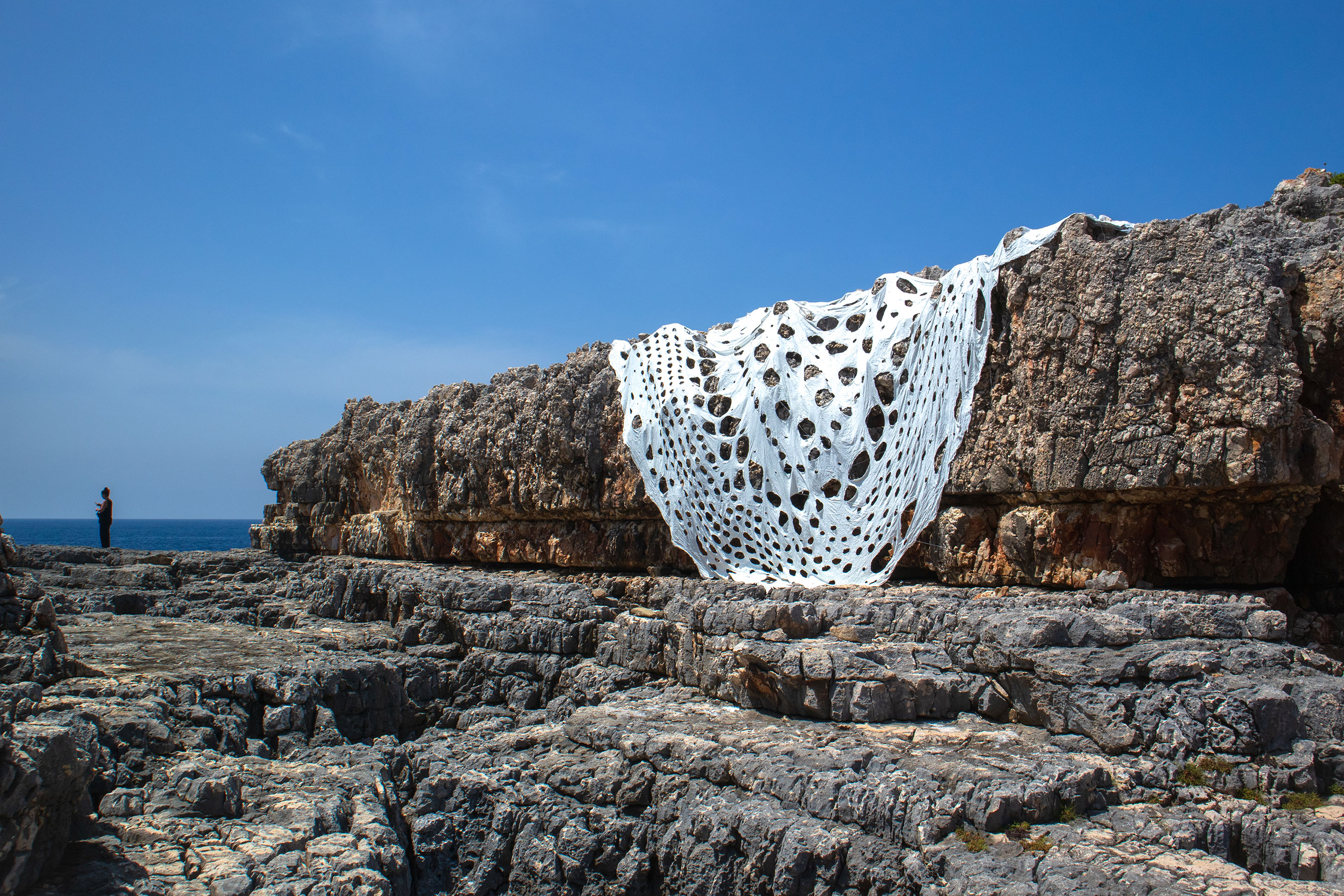





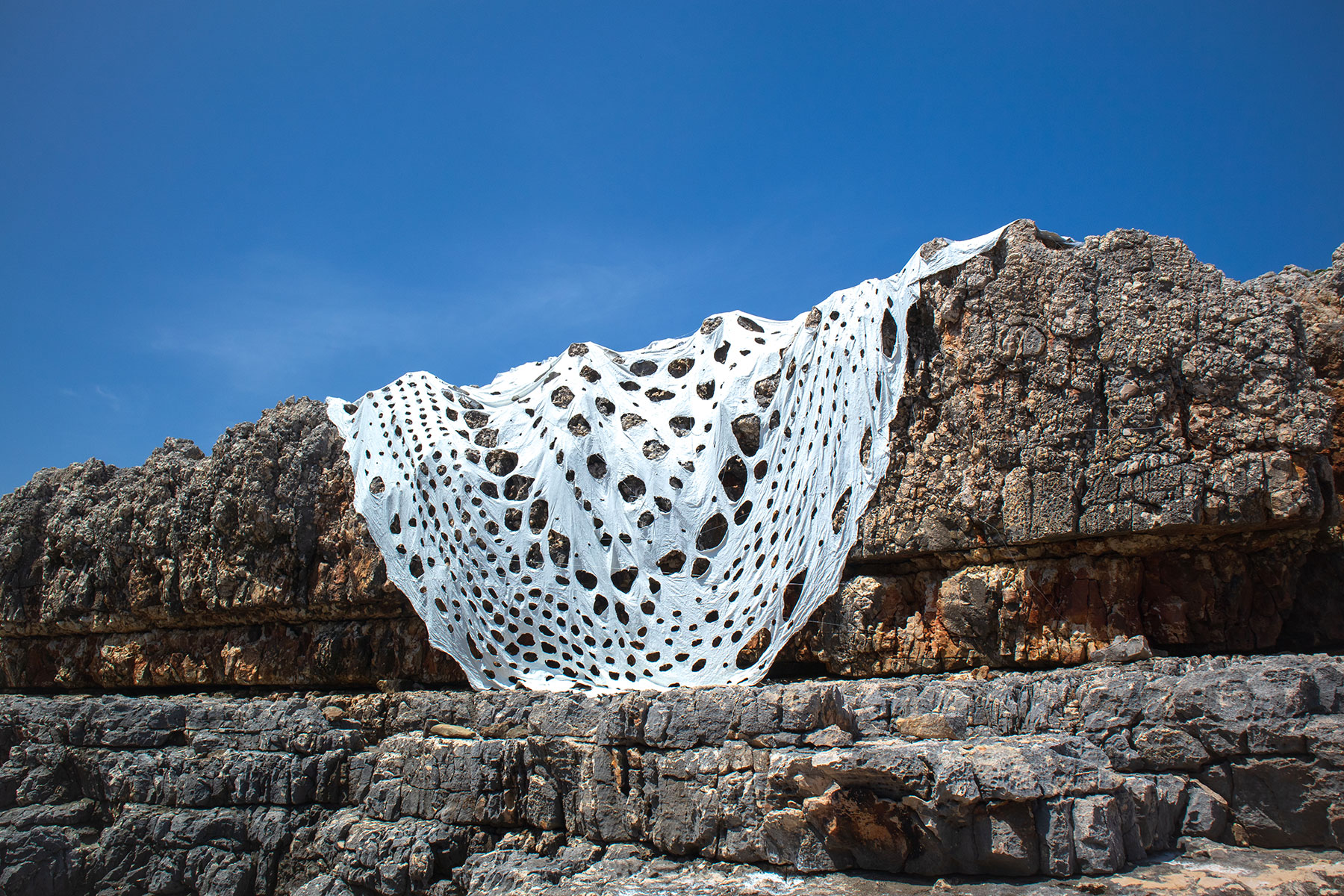

A NEW FRAGMENTED MEMORY by Dimitra Zervou
installation, 8x4,2m
fabric, concrete, iron
2024
location: 39°10'44.9"N 20°12'05.1"E
This artwork is based on the concept of memory, comprised of countless fragments. It aims to create a new perspective, by examining the idea of fragility. The piece juxtaposes the notion of fragility with the sturdiness of cement, suggesting that what we perceive as strong and stable can, in reality, be delicate; much like our memories. Central to the work is the interplay between the doily, symbolizing memory, and cement, embodying fragility. Through this union, the artwork redefines materials we typically label as masculine or feminine, merging them to craft a fresh narrative and a reimagined image of their essence.
www.instagram.com/dimitra.zervou/



Athina Koumparouli is an artist and art conservator based in Athens, Greece.
Her artistic practice is the result of multi-dimensional research in the fields of antiquities conservation, archaeological methodology, science fiction, biology, philosophy, post-industrial design, and speculative design, through which she creates sculptural installations that she refers to as “material narratives”.
Her research focuses on sites that are undergoing rapid change or transition; these locations can be industrial zones, regions that have recently experienced natural disasters, or even archaeological excavations.
She has studied Conservation of Antiquities and Works of Art in Athens and holds an MA in “Post-industrial Design and Artistic Practices”. Her work has been presented in group exhibitions both in Greece and internationally. She has participated in art residency programs in the Netherlands, Italy, and Greece. In 2022 she was awarded the Stavros Niarchos Foundation Artist Fellowship by ARTWORKS. In 2022-2023 with the support of Culture Moves Europe and the Goethe Institut, she developed an artistic research project in Rome during an ongoing excavation in collaboration with the University of Ferrara, furthering her ongoing research on the intersections of art/archaeology, material culture, and the living landscape.
Her artistic practice is the result of multi-dimensional research in the fields of antiquities conservation, archaeological methodology, science fiction, biology, philosophy, post-industrial design, and speculative design, through which she creates sculptural installations that she refers to as “material narratives”.
Her research focuses on sites that are undergoing rapid change or transition; these locations can be industrial zones, regions that have recently experienced natural disasters, or even archaeological excavations.
She has studied Conservation of Antiquities and Works of Art in Athens and holds an MA in “Post-industrial Design and Artistic Practices”. Her work has been presented in group exhibitions both in Greece and internationally. She has participated in art residency programs in the Netherlands, Italy, and Greece. In 2022 she was awarded the Stavros Niarchos Foundation Artist Fellowship by ARTWORKS. In 2022-2023 with the support of Culture Moves Europe and the Goethe Institut, she developed an artistic research project in Rome during an ongoing excavation in collaboration with the University of Ferrara, furthering her ongoing research on the intersections of art/archaeology, material culture, and the living landscape.


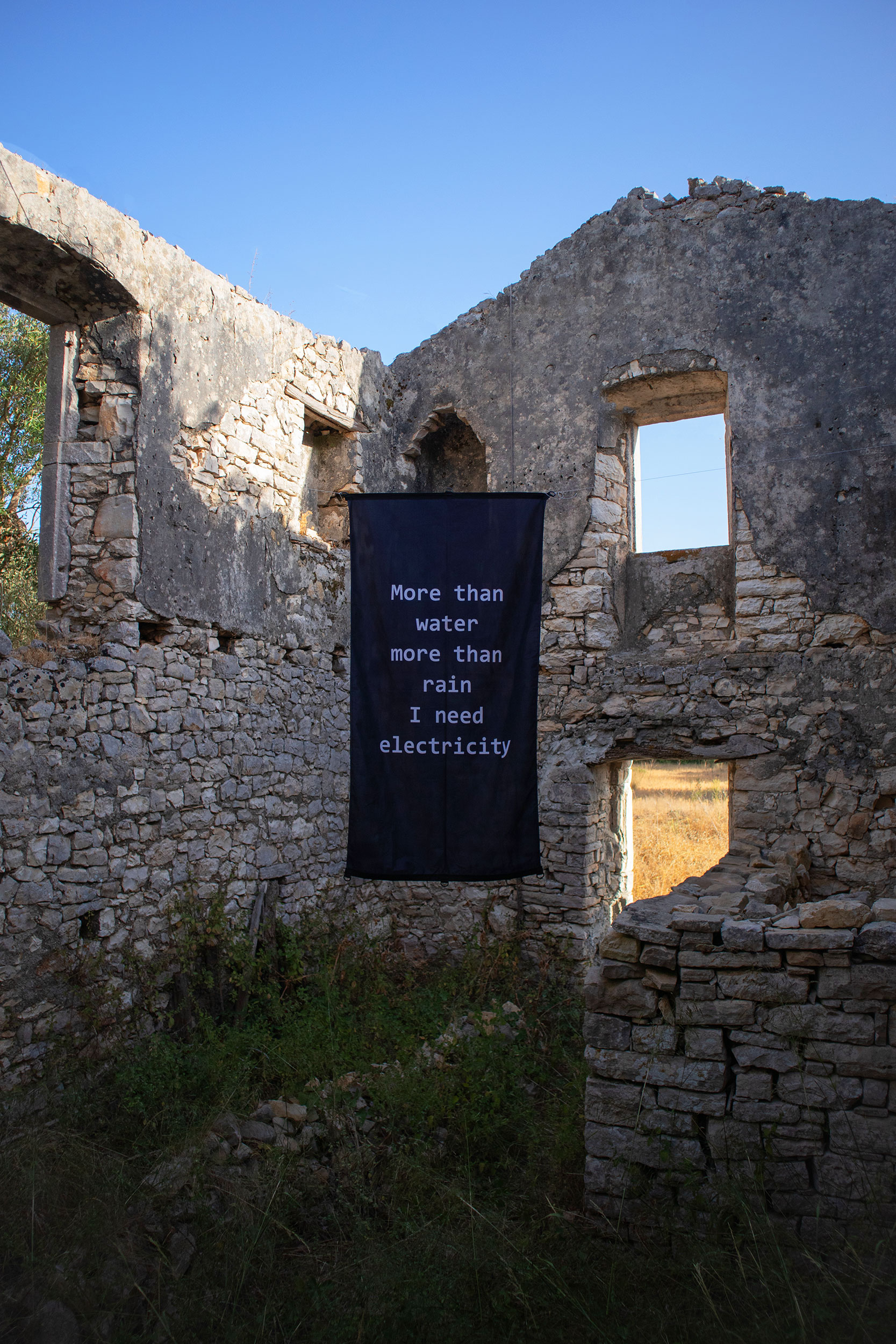

MORE THAN WATER, MORE THAN RAIN, I NEED ELECTRICITY
by Athina Koumparouli
installation, 160x90 cm
Polyester flag
2019
location: 39.184996, 20.196773
"More than water, more than rain, I need electricity" is part of a research project that was originally exhibited in Eindhoven during Dutch Design Week in 2019. The project tells the story of an industrial area that coexists with a Natura protected area, where rare species of flora and fauna thrive precisely because of water and soil contamination. Due to this unique condition, this site was the first where an industrially polluted area was legally protected for nature conservation.
The work ironically refers to today's dilemmas and strange new balances.
www.athinakubaruli.com/
by Athina Koumparouli
installation, 160x90 cm
Polyester flag
2019
location: 39.184996, 20.196773
"More than water, more than rain, I need electricity" is part of a research project that was originally exhibited in Eindhoven during Dutch Design Week in 2019. The project tells the story of an industrial area that coexists with a Natura protected area, where rare species of flora and fauna thrive precisely because of water and soil contamination. Due to this unique condition, this site was the first where an industrially polluted area was legally protected for nature conservation.
The work ironically refers to today's dilemmas and strange new balances.
www.athinakubaruli.com/


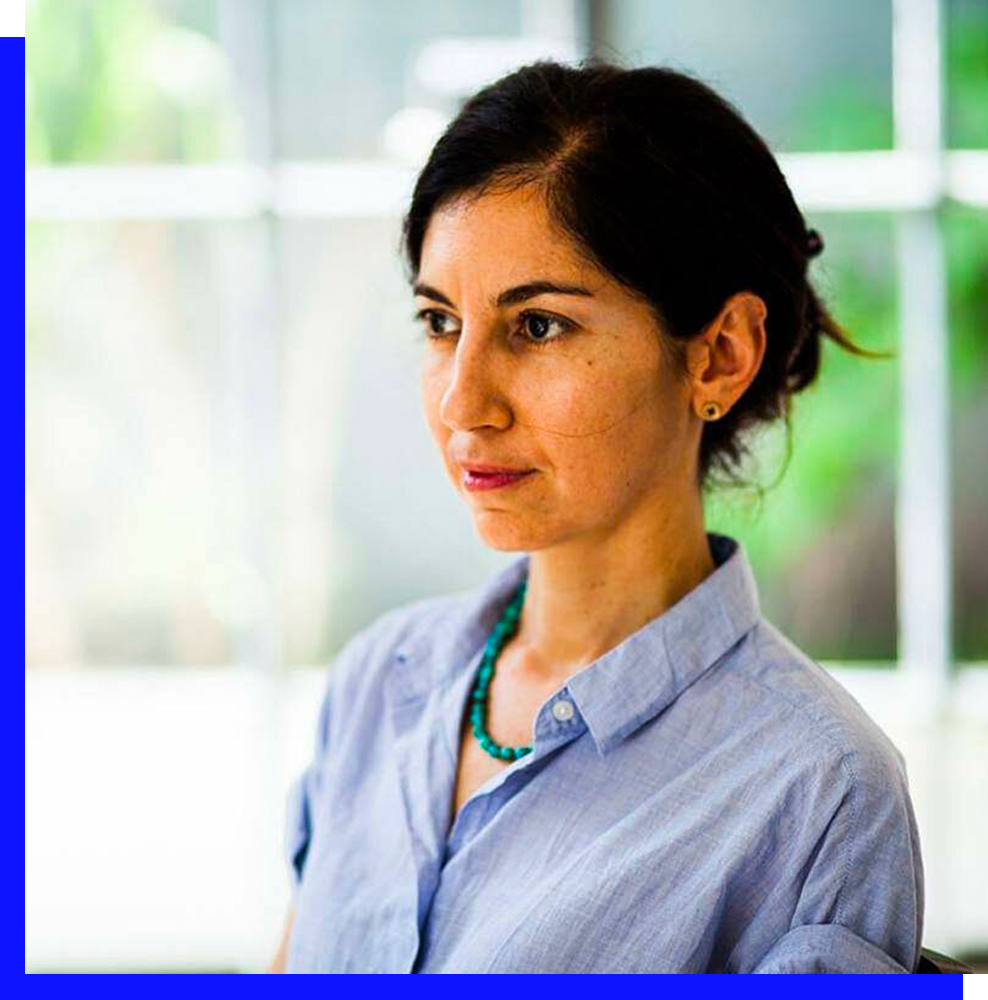
Glenda León (b. 1976 Cuba) lives and works in Havana and Madrid. Glenda’s sense of art has grown out of a multidisciplinary background and spiritual explorations. Her early interest in dance and choreography deepened her comprehension of a “whole”, combining mind, body, space, sound, and silence. Art History gave her a domain for investigation and widened her sources of influences. Her master’s degree in New Media at The Academy of Media Arts Cologne (KHM) broadened her spectrum of media and materials and evidenced her openness to experimentation. Her work incessantly defies our perception of the world, at times by making visible some of the laws of Nature and at others by emphasizing the act of listening as a necessary step to continue evolving.
The artist has exhibited individually in spaces such as the Museo de Arte Contemporánea de Vigo (2021; Spain), the Museo Extremeño e Iberoamericano de Arte Contemporáneo (2020; Spain) and the Centro Atlántico de Arte Moderno (2015; Spain). Likewise, she has been invited to the Aichi Triennale (2022; Japan), the 15th Cuenca Biennial (2021; Ecuador), the Guangzhou Image Triennial (2021; China), the Changwon Sculpture Biennale (2020; South Korea), the Dakar Biennale (2018; Senegal), the SITE Santa Fe Biennial (2014; USA), the 55th Venice Biennale (2013; Italy) and the Havana Biennial (2019, 2015, 2009, 2003; Cuba). Her recognitions include the Pilar Juncosa and Sotheby’s Biennial Award for Artistic Creation (2021), the DKV Prize (2020) and the Pollock-Krasner Foundation Grant (2020, 2005). Her work can be found in important public collections worldwide including Centre George Pompidou, Paris; Perez Art Museum Miami (PAMM), Miami; Art Gallery of Ontario (AGO), Toronto; The Hammer Museum, Los Angeles and The Museum of Fine Arts, Houston.
The artist has exhibited individually in spaces such as the Museo de Arte Contemporánea de Vigo (2021; Spain), the Museo Extremeño e Iberoamericano de Arte Contemporáneo (2020; Spain) and the Centro Atlántico de Arte Moderno (2015; Spain). Likewise, she has been invited to the Aichi Triennale (2022; Japan), the 15th Cuenca Biennial (2021; Ecuador), the Guangzhou Image Triennial (2021; China), the Changwon Sculpture Biennale (2020; South Korea), the Dakar Biennale (2018; Senegal), the SITE Santa Fe Biennial (2014; USA), the 55th Venice Biennale (2013; Italy) and the Havana Biennial (2019, 2015, 2009, 2003; Cuba). Her recognitions include the Pilar Juncosa and Sotheby’s Biennial Award for Artistic Creation (2021), the DKV Prize (2020) and the Pollock-Krasner Foundation Grant (2020, 2005). Her work can be found in important public collections worldwide including Centre George Pompidou, Paris; Perez Art Museum Miami (PAMM), Miami; Art Gallery of Ontario (AGO), Toronto; The Hammer Museum, Los Angeles and The Museum of Fine Arts, Houston.





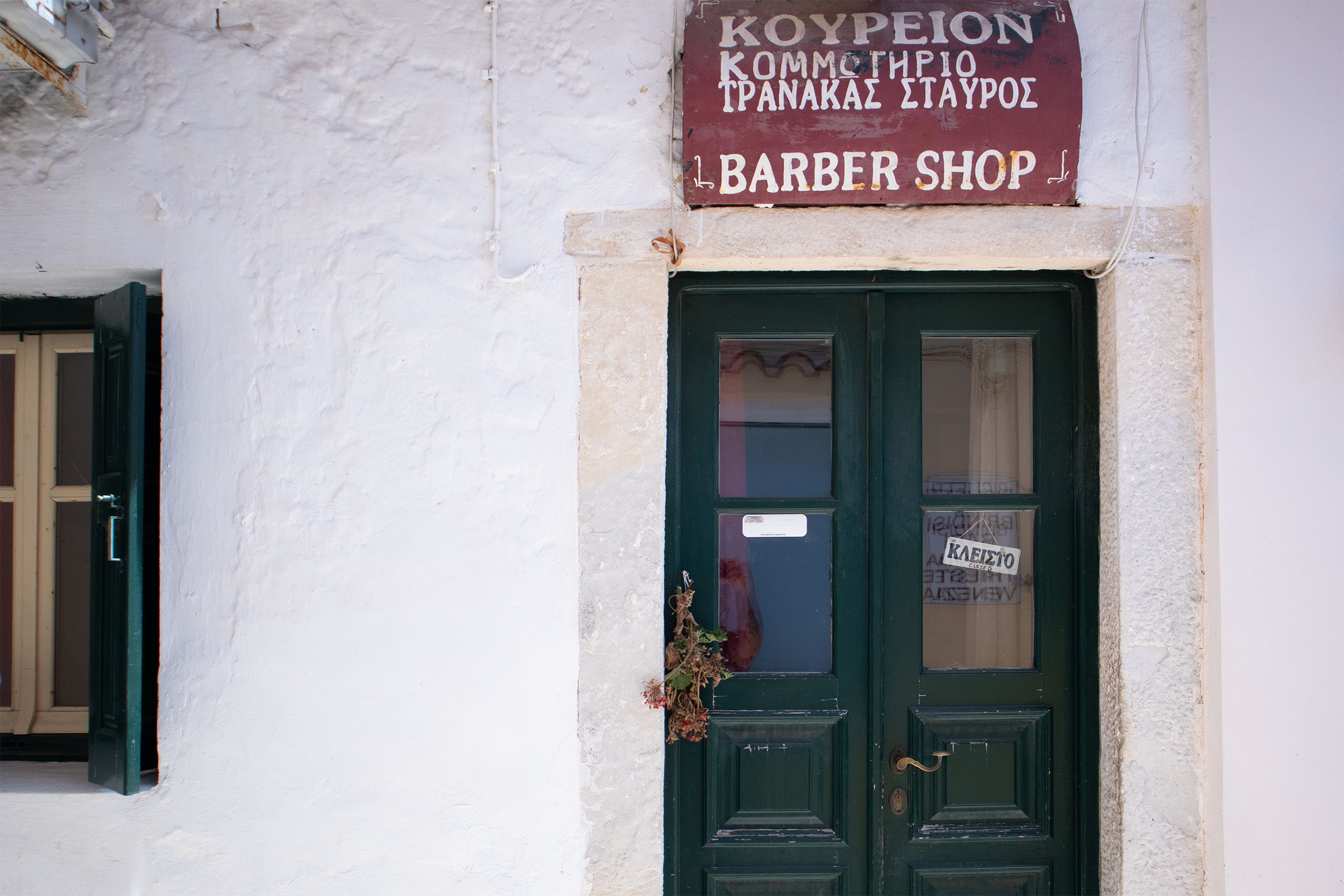




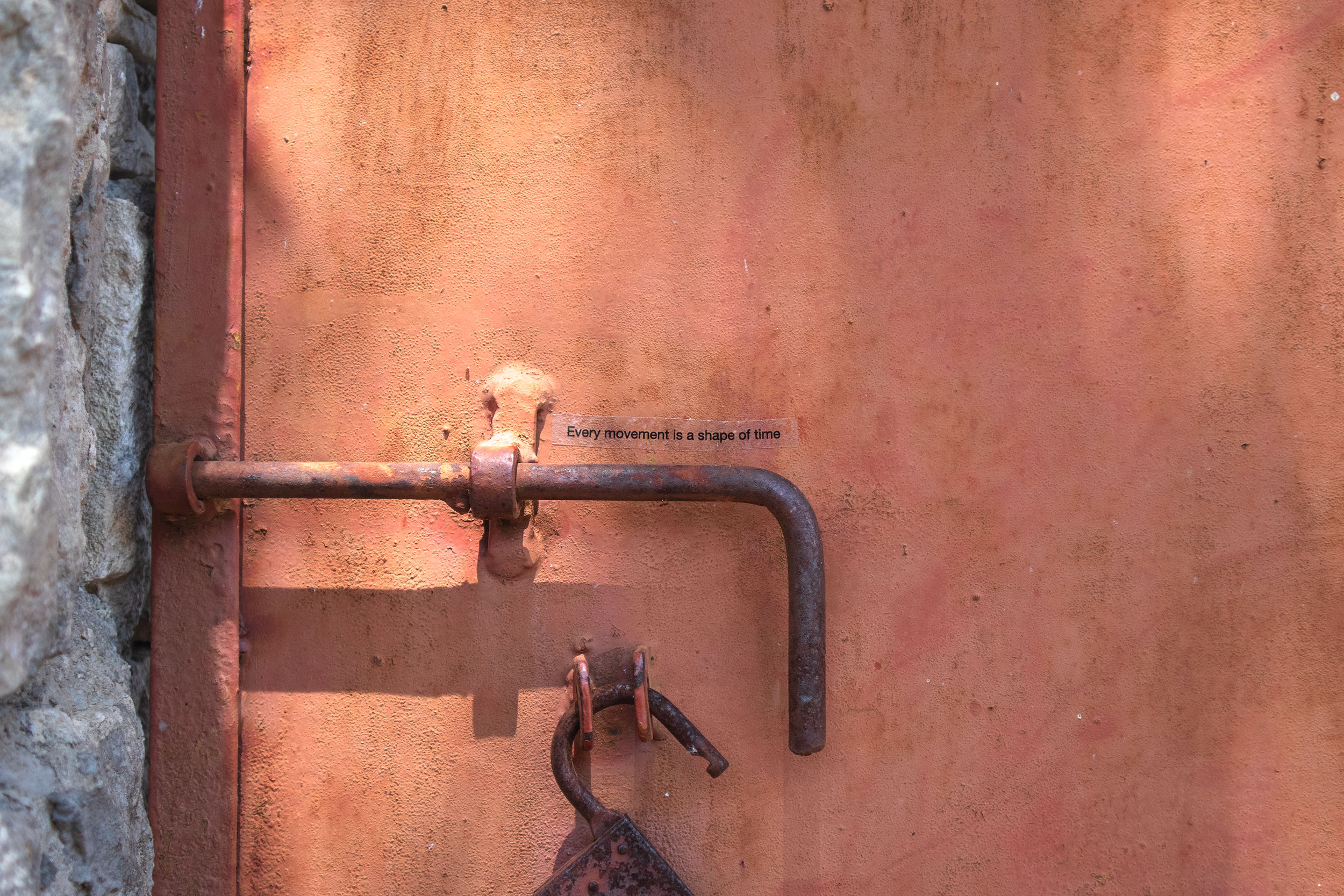



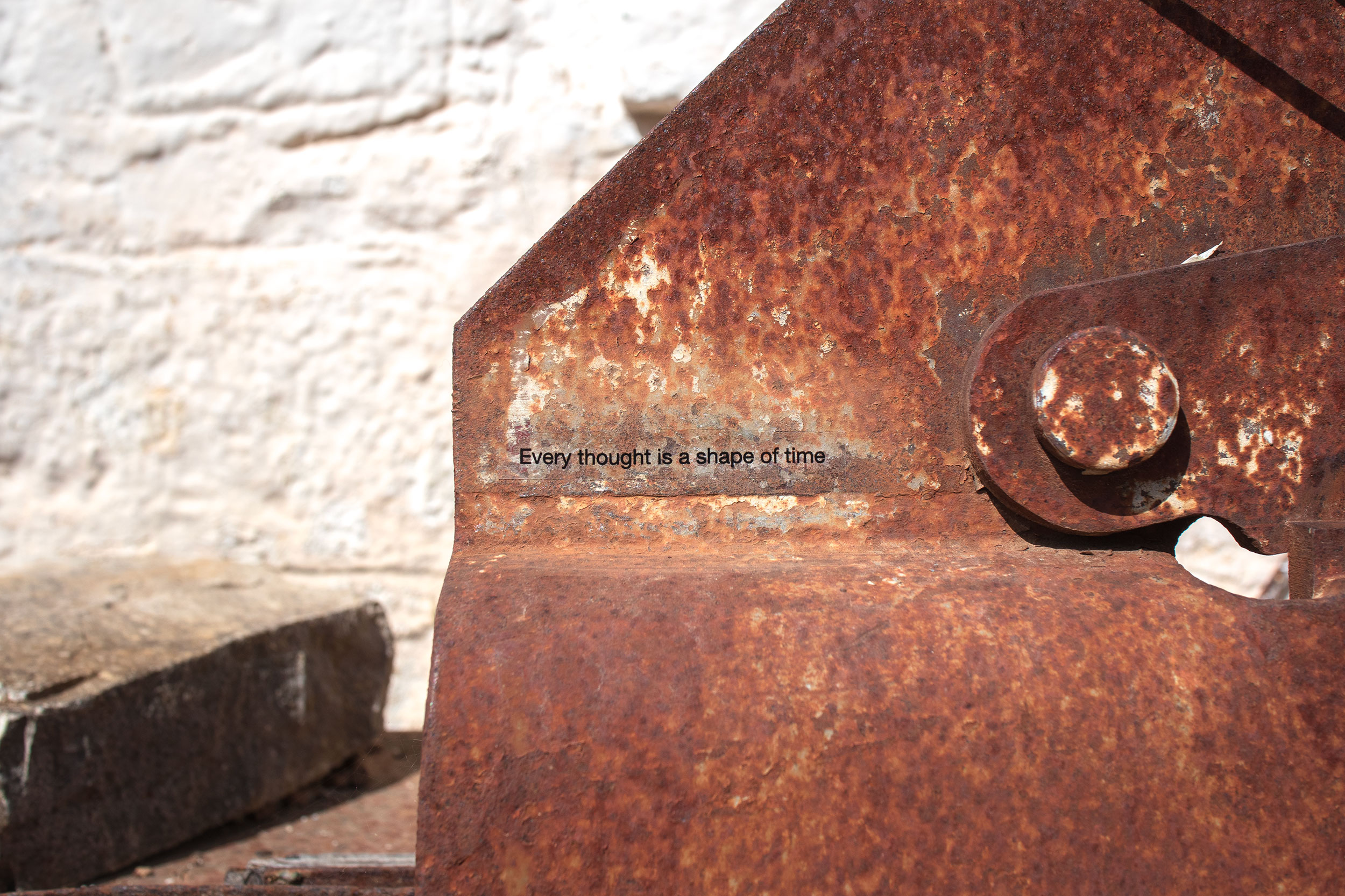

Every step is a shape of time
Every sound is a shape of time
Every gesture is a shape of time
Every smell is a shape of time
Every flower is a shape of time
Every movement is a shape of time
Every shape is a shape of time
Every thought is a shape of time
by Glenda León
outdoor intervention
adhesive paper
2024
https://www.glenda-leon.com/



The Krank (b. 1988 Greece) is a visual artist & curator living and working between Athens & Berlin. He studied Fine and Applied Arts in Athens (2009), focusing on paintings & art installations.
His work has been widely presented across Europe. Notable shows, installations & scenographies were in TYPO Berlin in Haus der Kulturen der Welt - Berlin 2016, Documenta Halle - Kassel 2017, KKL (Culture and Congress Center) - Luzern 2018, RÄUME 2 - Berlin Art Week 2018, World Conference Center - Bohn 2019, Museum of Now - Berlin 2020 & 2021, Michael Cacoyannis Foundation - Athens 2022, TedX aueb Athens Conservatoire - Athens 2023, Stegi Onassis - Athens 2023, SFVV Deutsche Historisches Museum - Berlin 2023, Eleusis European Capital of Culture - Eleusina 2023, Transmediale - Berlin 2024, Piraeus Municipal Art Gallery - Piraeus 2024.
His artworks belong to private collections in Europe, Asia, America & Australia, to The Solar Panel Art Series of Olafur Eliasson, to MON Collection of Contemporary Art & to SFVV Deutsche Historisches Museum in Germany. Mentions and interviews for his work can be found in greek and international press.
His work has been widely presented across Europe. Notable shows, installations & scenographies were in TYPO Berlin in Haus der Kulturen der Welt - Berlin 2016, Documenta Halle - Kassel 2017, KKL (Culture and Congress Center) - Luzern 2018, RÄUME 2 - Berlin Art Week 2018, World Conference Center - Bohn 2019, Museum of Now - Berlin 2020 & 2021, Michael Cacoyannis Foundation - Athens 2022, TedX aueb Athens Conservatoire - Athens 2023, Stegi Onassis - Athens 2023, SFVV Deutsche Historisches Museum - Berlin 2023, Eleusis European Capital of Culture - Eleusina 2023, Transmediale - Berlin 2024, Piraeus Municipal Art Gallery - Piraeus 2024.
His artworks belong to private collections in Europe, Asia, America & Australia, to The Solar Panel Art Series of Olafur Eliasson, to MON Collection of Contemporary Art & to SFVV Deutsche Historisches Museum in Germany. Mentions and interviews for his work can be found in greek and international press.






SOLD by The Krank
land art installation, 140m2
stones
2024
location: Avlaki Beach
The artwork "SOLD" is a typical example of land art, an artistic movement that incorporates and transforms the natural environment into a visual statement. This piece was created on a pebble beach using materials collected on site, with the dark stones forming the word "SOLD". The choice of the word "SOLD" is highly charged, suggesting the commodification and privatization of land. Placing the work in the immediate vicinity of a construction site where a luxury villa is being built intensifies the critical dialogue the artist seeks to provoke. The juxtaposition of the natural beauty of the beach with human intervention and development adds a dimension of timeliness and urgency to the work.
The use of natural materials and the surrounding space is a key element of land art, and in the case of "SOLD", The Krank succeeds in integrating his art inextricably with its environment. The placement of the word on the ground, reminiscent of the advertising banners used in real estate sales, serves as a form of protest against the commodification of natural resources. The work invites the viewer to consider the environmental and social consequences of selling and exploiting land. Through a simple yet powerful visual statement, The Krank raises questions about the value of nature and the need to protect it from over-exploitation and building development. SOLD is therefore not only an artistic creation, but also a political statement. In this way, The Krank adds its voice to a broader dialogue on environmental justice and sustainability.
www.behance.net/thekrank
The use of natural materials and the surrounding space is a key element of land art, and in the case of "SOLD", The Krank succeeds in integrating his art inextricably with its environment. The placement of the word on the ground, reminiscent of the advertising banners used in real estate sales, serves as a form of protest against the commodification of natural resources. The work invites the viewer to consider the environmental and social consequences of selling and exploiting land. Through a simple yet powerful visual statement, The Krank raises questions about the value of nature and the need to protect it from over-exploitation and building development. SOLD is therefore not only an artistic creation, but also a political statement. In this way, The Krank adds its voice to a broader dialogue on environmental justice and sustainability.
www.behance.net/thekrank
*Aerial photos by Industrial Drone Services


-
All images were taken by The Krank ︎
